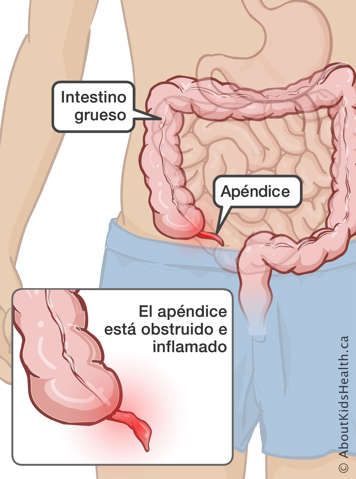¿Qué es la apendicitis?
La apendicitis es una inflamación o hinchazón del apéndice . El apéndice es una estructura tubular pequeña que se encuentra unida a la primera parte del intestino grueso, llamado colon. Se ubica en la zona inferior derecha del abdomen de su niño (vientre). No se le conoce ninguna aplicación en el cuerpo.

La apendicitis ocurre cuando el apéndice se obstruye. La obstrucción causa la inflamación del apéndice. La inflamación puede causar dolor, diarrea, vómitos y fiebre.
Si el médico piensa que su niño puede tener apendicitis, hará un examen físico. También puede ordenar un ultrasonido o una tomografía computarizada.
¿Qué es una apendicectomía?
Si su niño tiene apendicitis, por lo general significa que va a necesitar cirugía (una operación) para extirpar el apéndice. Esta operación se conoce como apendicectomía . Es un procedimiento simple y común. Esta cirugía normalmente no afecta el crecimiento del niño. Su niño podrá seguir digiriendo alimentos.
Una apendicectomía puede ser una cirugía de emergencia o una cirugía programada, dependiendo del estado de salud de su niño. El pediatra decidirá si su niño tiene que quedarse en el hospital o si puede venir al hospital el día de la cirugía.
Durante la apendicectomía
Su niño recibirá un “medicamento especial para dormir”, llamado anestesia general. Esto asegurará que su niño duerma durante la operación y no sienta dolor alguno.
El cirujano hará incisiones (cortes) en el abdomen de su niño. También puede usar una cámara llamada laparoscopio y hacer pequeños cortes. El cirujano extirpará el apéndice del niño y coserá el área del intestino a la que estaba unido. Por último, el cirujano cerrará las incisiones usando pequeñas porciones de cinta adhesiva estéril llamadas steri-strips.
Una apendicectomía lleva 1 hora, aproximadamente.
Después de la apendicectomía
Después de la apendicectomía, su niño irá a la Unidad de Cuidados Intensivos Posteriores a la Anestesia, conocida también como PACU, por su sigla en inglés, o a la sala de recuperación. Permanecerá ahí aproximadamente 1 hora. Usted podrá visitar a su niño una vez que se despierte. Después de eso su niño regresará a la unidad de ingreso. Permanecerá ahí entre 12 y 24 horas.
Su niño podrá volver a casa cuando:
- Las lecturas de frecuencia cardíaca, respiración, presión arterial y temperatura sean normales
- Pueda comer sin vomitar
- Se sienta cómodo tomando analgésicos por vía oral, es decir por boca
El cuidado de su niño en casa
Cuidado de la incisión
Las incisiones de la cirugía estarán cubiertas por unas vendas llamadas steri-strips. Usted no tiene que hacer nada con respecto a esas vendas. Lávese las manos antes de tocar o limpiar el área de la incisión.
Es común ver una pequeña cantidad de sangre sobre las vendas. Si la sangre parece fresca o si la cantidad de sangre aumenta, aplique presión sobre el área con un paño limpio durante 5 a 6 minutos. Luego, llame al consultorio del cirujano de su niño.
Si la hemorragia no para, lleve a su niño al médico o al servicio de urgencias.
Las vendas steri-strips se saldrán solas. Usted puede quitar estas vendas si, al término de 7 a 10 días después de la cirugía, no se han salido solas.
Actividades
Su niño puede retomar sus actividades habituales cuando se sienta capaz de hacerlo.
Dieta
Su niño debería poder volver a su dieta habitual después de la cirugía. Si su niño tiene problemas para comer, llame al consultorio del cirujano.
Analgésicos
Cuando su niño vuelva a casa, considere la posibilidad de administrarle acetaminofeno durante las primeras 24 horas después de la cirugía. Para saber la cantidad de medicamento que usted debe darle a su niño, siga las instrucciones del envase. Después de las primeras 24 horas, su niño puede tomar el analgésico cuando sea necesario.
Baño
Puede bañar a su niño 48 horas después de la cirugía.
Escuela
Su niño puede regresar a la guardería o a la escuela cuando se sienta capaz de hacerlo y cuando usted sienta que el niño puede retomar su rutina habitual.
Cuándo debe llamar al equipo quirúrgico
La mayor preocupación después de una apendicectomía es un absceso (infección). Llame al consultorio del cirujano si nota cualquiera de los siguientes signos o síntomas de infección:
- fiebre de 38,5 °C (101 °F) o más alta
- secreción amarillenta o verdosa, espesa y maloliente, proveniente del área de la incisión
- hemorragia en el área de la incisión
- enrojecimiento en el área de la incisión
- tumefacción o hinchazón en el área de la incisión
- dolor que empeora, a pesar de haber tomado analgésicos
- pérdida del apetito o presencia de vómitos
- dolor o distensión (hinchazón o sensación de estar lleno) del estómago
- su niño se siente aletargado, muy cansado o somnoliento
Si usted tiene alguna pregunta o inquietud que no es urgente, llame al consultorio del cirujano de su niño en el horario de atención a los pacientes, o deje un mensaje en el contestador automático si llama fuera de hora. Si usted tiene una preocupación urgente, lleve a su niño al médico de cabecera, al pediatra o al servicio de urgencias más cercano.
El cirujano de mi niño es:
Número telefónico:
El pediatra de mi niño es:
Número telefónico:
Puntos clave
- Si su niño tiene apendicitis, es probable que necesite cirugía (una operación) para extirpar el apéndice
- Dependiendo del estado de salud de su niño, la apendicectomía puede ser una cirugía de urgencia o una cirugía programada
- Su niño va a necesitar anestesia general para la operación
- Si su niño sangra mucho o si usted nota signos de infección, llame al consultorio del cirujano